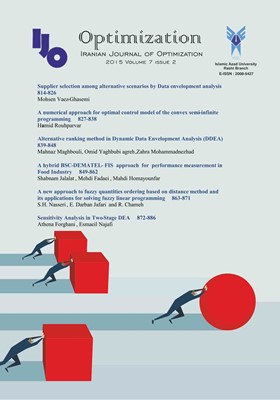A new approach to fuzzy quantities ordering based on distance method and its applications for solving fuzzy linear programming
محورهای موضوعی : linear ProgrammingSeyyed Hadi Nasseri 1 , Elham Darban Jafari 2 , Roghayyeh Chameh 3
1 - Department of Mathematics, University of Mazandaran, Babolsar, Iran
2 - Department of Mathematics, University of Mazandaran, Babolsar, Iran.
3 - Department of Mathematics, University of Mazandaran, Babolsar, Iran.
کلید واژه: fuzzy number, Fuzzy linear programming, simplex algorithm, fuzzy ordering,
چکیده مقاله :
Many ranking methods have been proposed so far. However, there is yet no method that can always give a satisfactory solution to every situation; some are counterintuitive, not discriminating; some use only the local information of fuzzy values; some produce different ranking for the same situation. For overcoming the above problems, we propose a new method for ranking fuzzy quantities based on the distance method. Then, an application of using fuzzy ordering in the fuzzy mathematical programming as well as fuzzy primal simplex algorithm is indicated. In particular, we emphasize that the fuzzy ordering will be useful when a decision maker needs to evaluate the optimality condition in any solving process.
Many ranking methods have been proposed so far. However, there is yet no method that can always give a satisfactory solution to every situation; some are counterintuitive, not discriminating; some use only the local information of fuzzy values; some produce different ranking for the same situation. For overcoming the above problems, we propose a new method for ranking fuzzy quantities based on the distance method. Then, an application of using fuzzy ordering in the fuzzy mathematical programming as well as fuzzy primal simplex algorithm is indicated. In particular, we emphasize that the fuzzy ordering will be useful when a decision maker needs to evaluate the optimality condition in any solving process.
[1] S. Abbasbandy and B. Asady, Ranking of fuzzy numbers by sign distance, Information Sciences, 176 (2006) 2405-2416.
[2] B. Asady and A. Zendehnam, Ranking fuzzy numbers by distance minimization, Applied Mathematical Modeling, 31(11) (2007) 2589-2598.
[3] G. Bortolan and R. Degani, A review of some methods for ranking fuzzy subsets, Fuzzy Sets and Systems, 15 (1985) 119.
[4] S.J. Chen and C.L. Hwang, Fuzzy Multiple Attribute Decision Making, Springer, Berlin, (1992).
[5] L.H. Chen and H.W. Lu, An approximate approach for ranking fuzzy numbers Based left and right dominance, Computers and Mathematics with Applications, 41 (2001) 1589- 1602.
[6] C.H. Cheng, A new approach for ranking fuzzy numbers by distance method, Fuzzy Sets and Systems, 95 (1998) 307-317.
[7] T.C. Chu and C.T. Tsao, Ranking fuzzy numbers with an area between the centroid point and original point, Computers and Mathematics with Applications, 43 (1/2) (2002) 111-117.
[8] Y. Deng, Z.F. Zhu and Q. Liu, Ranking fuzzy numbers with an area method using radius of gyration, Computers and Mathematics with Applications, 51 (2006) 1127-1136.
[9] P. Fortemps and M. Roubens, Ranking and defuzzification methods based on area compensation, Fuzzy Sets and Systems, 82 (1996) 319-330.
[10] A. Kaufmann and M.M. Gupta, Introduction to Fuzzy Arithmetic: Theory and Applications, Van Nostrand, New York, (1985).
[11] H. Lee-Kwang and J.H. Lee, A method for ranking fuzzy numbers and its application to decision-making, IEEE Transactions on Fuzzy Systems, 7 (1999) 677-685.
[12] T. Liou and J. Wang, Ranking fuzzy numbers with integral value, Fuzzy Sets and Systems, 50 (1992) 247-255.
[13] X.W. Liu and S.L. Han, Ranking fuzzy numbers with preference weighting function expectations, Computers and Mathematics with Applications, 49 (11-12) (2005) 1731-1753.
[14] N. Mahdavi Amiri and S.H. Nasseri, Duality results and a dual simplex method for linear programming with trapezoidal fuzzy variables, Fuzzy Sets and Systems, 158(17) (2007) 1961-1978.
[15] N. Mahdavi Amiri, S.H. Nasseri and A. Yazdani, Fuzzy primal simplex algorithms for solving fuzzy linear programming problems, Iranian Journal of Operational Research, 1(2) (2009) 68-84.
[16] H. Mishmast Nehi, H. Hajmohamadi, A ranking function method for solving fuzzy multi-objective linear programming problem, Annals of Fuzzy Mathematics and Informatics, 3(1) (2012) 31- 38.
[17] M. Modarres and S. Sadi-Nezhad, Ranking fuzzy numbers by preference ratio, Fuzzy Sets and Systems, 118 (2001) 429-436.
[18] S.H. Nasseri, Ranking trapezoidal fuzzy numbers by using Hadi method, Australian Journal of Basic and Applied Sciences 4(8) 3519-3525.
[19] S.H. Nasseri and O. Khazaee Kohpar, Pareto-optimal solutions in multi-objective linear programming with fuzzy numbers, Annals of Fuzzy Mathematics and Informatics, 9(5)(2015) 823-833.
[20] S.H. Nasseri and Sh. Mizuno, A new method for ordering triangular fuzzy numbers, Iranian Journal of Optimization, 2 (2010) 603-613.
[21] S.H. Nasseri and M. Sohrabi, Hadi method and its advantage in ranking fuzzy numbers, Australian Journal of Basic Applied Sciences 4 (10), 4630-4637.
[22] S.H. Nasseri, F. Taleshian, Z. Alizadeh and J. Vahidi, A new method for ordering LR fuzzy number, The Journal of Mathematics and Computer Science, 4(3) (2012) 283-294.
[23] S.H. Nasseri, M.M. Zadeh, M. Kardost and E. Behmanesh, Ranking fuzzy quantities based on the angle of the reference functions, Applied Mathematical Modelling, 37(22) (2013) 9230-9241.
[24] H. Sun and J. Wu, A new approach for ranking fuzzy numbers based on fuzzy simulation analysis method, Applied Mathematics and Computation, 174 (2006) 755-767.
[25] L. Tran and L. Duckstein, Comparison of fuzzy numbers using a fuzzy distance measure, Fuzzy Sets and Systems, 130 (2002) 331-341.
[26] X. Wang and E.E. Kerre, Reasonable properties for the ordering of fuzzy quantities (I), Fuzzy Sets and Systems, 118 (2001) 375-385.
[27] Y.J. Wang and H.S. Lee, The revised method of ranking fuzzy numbers with an area between the centroid and original points, Computers and Mathematics with Applications, 55 (9) (2008) 2033-2042.
[28] Z.X. Wang and Y.J. Liu, Z.P. Fan, B. Feng, Ranking LR fuzzy number based on deviation degree, Information Sciences, 179(13) (2009) 2070-2077.
[29] J. Yao and K. Wu, Ranking fuzzy numbers based on decomposition principle and signed distance, Fuzzy Sets and Systems, 116 (2000) 275-288.


